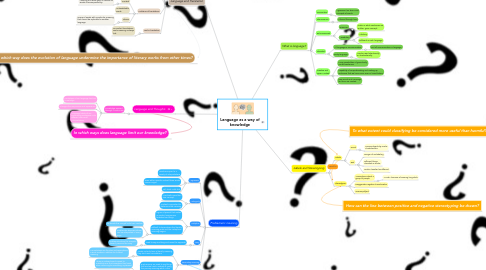
1. Language and Translation
1.1. Many different languages
1.2. Privileged relationship with our native language
1.3. Unthinking linguistic chauvinism
1.4. Different languages divided the world up in different ways.
1.5. Problems of translations
1.5.1. Context
1.5.1.1. Meaning of a word given in relation to words its accompained by
1.5.2. Untranslatable words
1.5.3. Idioms
1.5.3.1. Group of words with a particular meaning that cannot be replicated in another language
1.6. Lost in translation
1.6.1. No perfect translations, some meaning is always lost.
2. Problematic meaning
2.1. Vagueness
2.1.1. Words are open to a variety of interpretations
2.1.2. Even within specific context these words remain vague
2.1.3. Tall, short, cold, hot
2.2. Ambiguity
2.2.1. Word with more than one concept.
2.2.2. Context is important to determine the meaning
2.3. Metaphor
2.3.1. Figure of speech that makes an implicit comparison between two things
2.3.2. Difficult to know where the literally meaning ends and the metaphoric meaning begins
2.3.2.1. To decide this, we get hints from context
2.3.2.2. Problematic because phrase can be interpreted in many ways
2.4. Irony
2.4.1. Used to say one thing and mean the opposite
2.4.1.1. Problematic when the receptor doesn’t perceive the irony
2.5. Secondary meaning
2.5.1. Words not only have a literally meaning, they also have connotations
2.5.1.1. Connotations are the idea and associations a word evokes in addition to its literal meaning
2.5.2. Euphemisms are used to say things that are too harsh, instead of using the primary meaning which is the literally one.
2.5.2.1. When an indirect word is used to substitute one that considered too harsh when referrinng to something unpleasant
2.5.2.2. This may cause the direct meaning of a word to be lost.
3. To what extent does the use euphemisms jeopardize the meaning of what we try to say?
4. Language and Thoughts
4.1. Knowledge aquired through LANGUAGE
4.1.1. Limitations of our language limit our knowledge
4.1.2. Changes the way we see and experience
4.1.3. Language habits of our community predispose us to different choices of interpretations
5. In which ways does language limit our knowledge?
6. In which way does the evolution of language undermine the importance of literary works from other times?
7. What is language?
7.1. Convention
7.1.1. Agreement on terms and concepts of words
7.2. Phenomenon
7.2.1. Alterred through time
7.3. Rule Governed
7.3.1. Grammar
7.3.1.1. Order in which sentences are written, gives concept.
7.3.2. Vocabulary
7.3.2.1. Arbitrary
7.3.2.2. Different in each language
7.4. Intended
7.4.1. All language is communication,
7.4.1.1. Not all communication is language.
7.4.2. Body language
7.4.2.1. May be used intentionally or unintentionally
7.5. Creative and Open Minded
7.5.1. Many possibilities of gramatically correct sentences
7.5.2. Capability of comprehending and making up sentences that we have never seen or heard before
7.5.3. New words and meanings for them are created
8. Labels and Stereotyping
8.1. Labels
8.1.1. Good
8.1.1.1. Groups objects by similar characteristics
8.1.2. Bad
8.1.2.1. Danger of mislabeling
8.1.2.2. Different things classified as similar
8.1.2.3. Similar classified as different
8.2. Stereotypes
8.2.1. Assumptions about a group of people
8.2.1.1. "Prude" because of wearing long skirts
8.2.2. Exaggerates negative characteristics
8.2.3. Oversimplifyed

